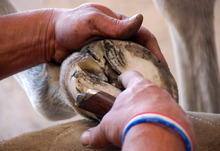Wet winter weather can bring horse hoof problems, especially if horses are relegated to stalls where bedding and matting is not kept clean and dry and where waste products are allowed to build up.

Importance of regular hoof examinations
Knowledge of the anatomy of the horse's foot including the hoof and all its internal structures is of paramount importance in being able to assess the condition of the horse's lower limbs and feet.
Knowledge of the anatomy of the horse's foot including the hoof and all its internal structures is of paramount importance in being able to assess the condition of the horse's lower limbs and feet.
Damage and injury are usually evidenced by lameness, wounds, lacerations or abrasions, cracks in hoof wall, tenderness to the touch, or other visual clues.
One problem that often arises during wet weather is thrush. Thrush is a painful bacterial infection of the frog resulting in a foul smelling, dark, clay-like material in the area surround the frog. It results from the frog being consistently packed with manure, mud or moist bedding combined with lack of basic hoof care such as regular picking and brushing. If not treated promptly it results in infection of the sensitive laminae and may infect the digital cushion leading to lameness.
Horse owners should inspect horse's hooves daily and watch for any signs of thrust or other conditions that can lead to lameness. Knowing what a healthy hoof looks like is important for all owners and farriers.
According to Dr. Candace Platz, a specialist in hoof care, a healthy frog is essential to the optimal physiological and mechanical function of the horse’s foot. Unhealthy frogs can significantly reduce a horse’s athletic performance by causing pain, impaired function, inflammation, and by becoming a source of chronic infection.
Yet the structure, function and appearance of a truly healthy frog is poorly understood by many hoof care
professionals. Veterinarians, farriers and barefoot trimmers are often taught using texts depicting “normal” frogs which are, in fact, atrophied, contracted or diseased.
Therefore, what is taught as “normal” is not necessarily healthy. Understandably, with this image in mind, hoof care professionals too often fail to consider the unhealthy frog as an underlying cause of foot pain and lameness.
The black malodorous discharge of classic thrush is often the only frog disease taught to veterinary students and farriers. But if we are to do justice to our roles as equine health care providers, it is essential to learn to recognize, treat and prevent the full spectrum of frog disease that affects domestic horses.
The healthy frog is made of very dense, firm and resilient tissue, strong enough to resist indentation by a sharp object. Its appearance is generally smooth, free of flaps, holes, fissures or undermining layers. It is divided by a central sulcus that is dry and solid. The central sulcus should be wide and shallow enough to be easily visualized, cleaned and probed throughout its entire length and depth without discomfort.
There should be no slits, pockets or fissures on the side walls of the grooves or sulcus. Caudally it should widen and blend smoothly and strongly to form a solid connection with the heel bulbs.
Similarly, the depths of the collateral grooves where the frog horn joins the horn of the sole should be dry and firm. The collateral grooves should be available for cleaning, probing and inspecting throughout their entire length, including the deepest parts.
They should be free of snags, rough spots or sensitivity. The junction of frog and sole horn should be tight, without any soft, discolored or punky areas. The frog should not “mushroom” laterally over the grooves, which obscures visualization and provides a haven for microbes.
The frog should be tall enough to make ground contact throughout most, if not all, of its length, most importantly toward the back of the foot. It should not be so tall that it is forced to the side or split on weight bearing.
By inspecting horses' hooves frequently and making sure that farrier care is scheduled regularly, your horse should have a healthy winter season without any of the problems related to wet weather.
